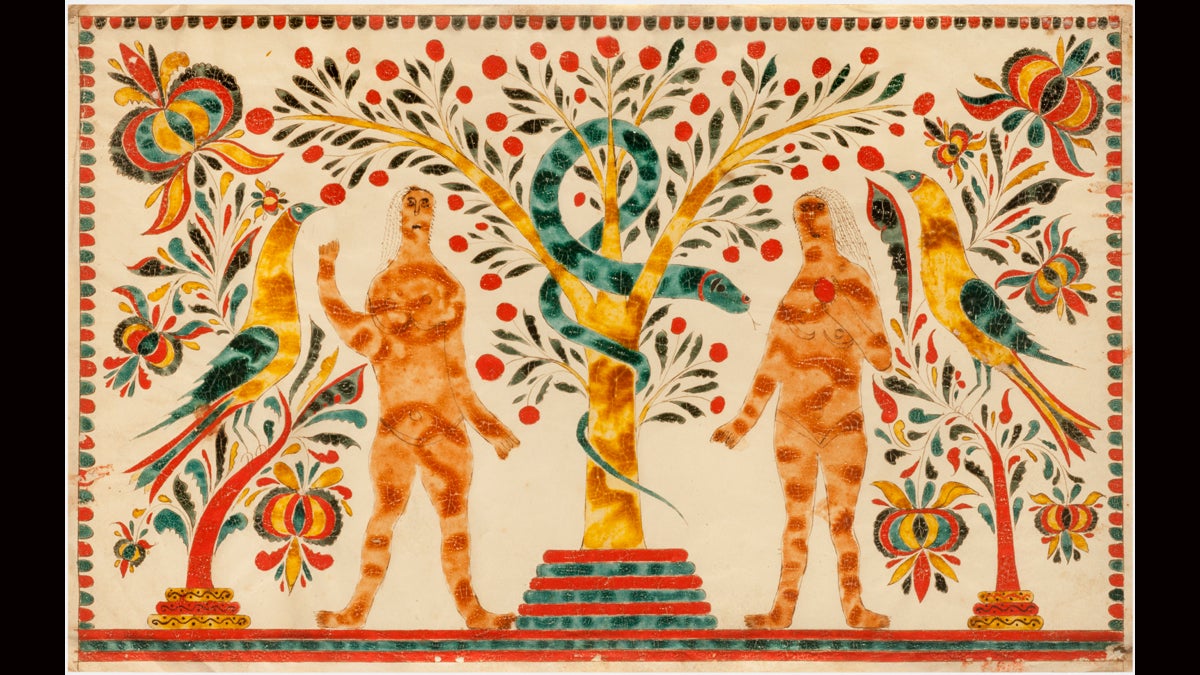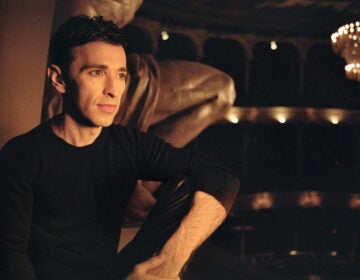Bright hallmarks of early German immigrants, fraktur collection goes to Philly art museum
Listen
Drawing of Adam and Eve, c. 1834‑1835. Attributed to Samuel Gottschall, American, 1808 ‑ 1898. Watercolor and ink on wove paper, 8 × 12 1/2 inches (20.3 × 31.8 cm). 125th Anniversary Acquisition. Promised gift of Joan and Victor Johnson. (Image courtesy of the Philadelphia Museum of Art)
Life was not easy for many of the German immigrants who arrived in Philadelphia in the 18th century. They dispersed throughout Southeastern Pennsylvania in search of economic prosperity and religious freedom.
Farming, building churches, opening schools and businesses, they cultivated their corner of their new country. And they brought with them an old folk art tradition — fraktur.
More than 200 frakturs — brightly illustrated manuscripts, drawings and artifacts — collected for 60 years by Jean and Victor Johnson will become part of the Philadelphia Museum of Art collection.
Their story is told in the exhibition “Drawn with Spirit.”
When a circus visited Lancaster in 1780, camels and other exotic animals made their way into the decorative drawing of Pennsylvania German draftsmen who incorporated what they saw, and what they imagined, into their art.
They followed the German tradition of adorning documents, Bibles and school lessons with colorful images of birds, plants , flowers — real or imaginary — buildings and people celebrating family and communal events. Biblical passages were constant sources of inspiration, hence the multitude of angels and archangels.
They framed the different texts with the characteristic German typographic style called fraktur.
Historian Lisa Minardi wrote the 400-page illustrated catalog that accompanies the exhibition.
The art form and lettering were not “a full-time occupation for the schoolmasters and ministers that made the frakturs because these pieces were made as gifts for school children … maybe you charge a few pennies for it, you were not making a living,” she said. “But those were the people who were literate, had access to materials, and had access to the clients, either schoolchildren or the kids that you were baptizing.”
Being able to draw and write was essential for educators, Minardi said, because their jobs depended on it.
“There was no tenure, and they were hired from term to term,” she said. “They wanted the parents to be happy with them so they got hired again for the next term. So when a child learned their ABCs or were particularly good, [the schoolmaster] would give them a drawing of a bird or a flower as reward of merit, a positive incentive.”
To gather the collection, Jean and Victor Johnson travelled around Pennsylvania, purchasing fraktur at auctions and small shops. All of a sudden, Jean Johnson said, she had “frackturitis.”
She was hooked by “the quirkiness, the charm, the design of it, the artistic colors.
“I just thought it was wonderful art I had never heard of,” Johnson said.
One of her favorite frakturs is “a picture of many churches with little numbers above the churches, and on the bottom it tells you about what each church is in German.
“And then, at the very bottom, it says, ‘God bless every man in America.’ It’s just so touching, they were proud , there were eagles and all kinds of symbols for America in it ,” Johnson said. “They were thrilled to be here, but they didn’t want to lose their tradition. And that’s what these frakturs are.”
The illustrated documents had another very important function in the Pennsylvania German communities, Minardi said.
“People emigrated to Pennsylvania, and it was wilderness, ” she said. “There are no churches or pastors, so there’s a shortage for most of the 18th century. They have to develop their own system of recordkeeping, and that’s why we see this genealogical focus on these certificates because there isn’t a parish register where we can look that information up.”
So the frakturs served as witnesses to growing, thriving immigrant communities though birth and wedding certificates, official documents and church events. All decorated in bright colors and line drawings.
WHYY is your source for fact-based, in-depth journalism and information. As a nonprofit organization, we rely on financial support from readers like you. Please give today.




